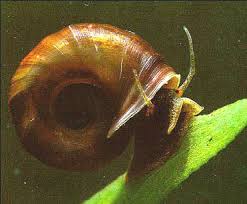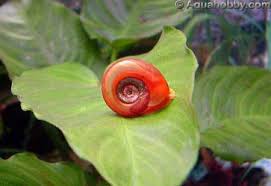|
|||||||
| Γλυκό νερό - Γενικά Οτι δεν εμπίπτει στις εξειδικευμένες κατηγορίες. |
 |
|
|
Εργαλεία Θεμάτων | Τρόποι εμφάνισης |
|
#1
|
||||
|
||||
|
Μηπως ξερει κανεις να μου πει..πως λεγονται?
φαινονται 3 στη φωτο.. το σωμα τους ειναι κοκκινο, σε αλλα σκουρο σε αλλα ποιο ανοιχτο. το καυκαλο τους ειναι καφε.. φυτα δεν τρωνε.. οποια πληροφορια καλοδεχουμενη.. 
__________________
O Βελλερεφόντης!!! part 1 & part 2 where there is will, there is a way    Μηνιαίες συναντήσεις ΠΣΦΕ - Κλιμάκιο Βόρειας Ελλάδας   |
|
#2
|
||||
|
||||
|
κανενας....?
   
__________________
O Βελλερεφόντης!!! part 1 & part 2 where there is will, there is a way    Μηνιαίες συναντήσεις ΠΣΦΕ - Κλιμάκιο Βόρειας Ελλάδας   |
|
#3
|
||||
|
||||
|
Δεν φαίνονται πολύ καλά στη φώτο, αλλά μοιάζουν με ramshorn snails (Planorbis planorbis). Έχω αρκετά από αυτά και δεν μου τρώνε φυτά. Τα βάζω στα ενυδρεία των μονομάχων και στα grow-out tanks για να τρώνε τα υπολείμματα τροφής. Αν θες κάνε ένα search για περισσότερες πληροφορίες...
|
|
#4
|
||||
|
||||
|
ναι ναι!!!!!!!!!!!
αυτα ειναι, μετα τη βοηθεια και του deMetrIs τα βρηκααα!!!    και καποιες πληροφοριες...οντως ειναι οπως τα λεει.. Ramshorn snails are very common and come in various sizes. Their shape is as their name suggests. The smaller varieties (under 1 cm) are not too damaging to a plant tank, although they seem to relish the tender leaves of the Hygrophila family. The other type is the dark and light brown striped Columbian Ramshorn that can grow big as large as 2 inches in diameter. The stripes run the length of the shell with a pattern of random width light-dark- light stripes that stays constant throughout the snails life. These snails are extremely prolific and have a terrific appetite for plants. Snails lay eggs on the plants in the pond, the eggs are covered in jelly to protect them. When the eggs hatch they are full of little baby snails. These snails use lungs to breathe air, but since they can trap and store some air inside their shells, they can tolerate water with low dissolved oxygen. Position in Food chain
They lay disk-shaped gelatinous clusters of eggs adhering to anything - plants, rocks etc. Plants also seem to be a choice for egg-laying. The ramshorn snails are all shaped like a flat coil, or the horn of ram. The genus Helisoma are American snails. The most popular of this group is from South America, does well in heated aquaria with little attention and is often introduced by accident where it breeds prolifically. This is the red ramshorn. The genera Planorbarius and Planorbis are found in cold waters, and thus are suitable for ponds. The Planorbarius snails may be up to 3cm in diameter, while the Planorbis grow only to 1.5cm. P.corneus, the Great Ramshorn, is brick red in colour, and likes still or slow-moving water. It will eat any detritus, both plant and animal, that it comes across. Like the apple snail, it is amphibious. The snails are hermaphrodite, and lay disk-shaped gelatinous clusters of eggs adhering to anything - plants, rocks etc. RAMSHORN SNAILS (PLANORBIS CORNEUS) A generation ago, the European Red Ramshorn Snail was a common sight in freshwater aquariums. Today they are somewhat of a rarity due to careless breeding with the common ramshorn snail that has a less interesting brown body color. We offer both the red and the brown ramshorn snails. The brown ramshorns are somewhat hardier, but both varieties are excellent choices for the freshwater aquarium as long as they are not kept together! If they are kept together, virtually all future generations will be brown, since the red color is a recessive characteristic. Culture Procedure:
Ramshorn snails are hardy and will thrive and multiply without attention in a freshwater aquarium (assuming the absence of snail eating fish!). They are excellent scavengers, eating algae, left over fish foods, etc. Usually they do minimal damage to plants. To grow the finest specimens, the snails should be given plenty of room, warmth and food. Water should be slightly alkaline. Temperature is best at 75 to 80 F. Preferred foods include spinach, lettuce, hair algae, shrimp based fish foods and carrot. Siphon off the bottom of the culture tank frequently and replace with aged freshwater. The flat amber egg masses will hatch within 12 to 40 days depending on temperature. Ramshorn snails are very common and come in various sizes. Their shapeis as their name suggests. The smaller varieties (under 1 cm) are not too damaging to a plant tank, although they seem to relish the tender leaves of the Hygrophila family. The other type is the dark and light brown striped Columbian Ramshorn that can grow big as large as 2 inches in diameter. The stripes run the length of the shell with a pattern of random width light-dark- light stripes that stays constant throughout the snails life. These snails are extremely prolific and have a terrific appetite for plants. These snails have a flat-coiled shell. The maximum shell diameter is just over ¾”. Unlike the MTS, these are always visible, not minding the light at all. They too are plant-harmless IME. These reproduce by means of the familiar flattened, dense jelly-like egg masses spotted freely on any potentially algae-growing area. These egg masses are clear to light amber in color, with the dark eggs or embryos showing clearly. I have never found a fish that will eat or disturb the egg mass, but there may be such around. Any snail-eating fish will devour the adult form of these beasts. They have no opercula, so are available to snail-slurpers and snail-grinders alike. Many fish will devour the small young of these snails, but they can still become population problems in overfed tanks. By the way, they are easy to color select. I have selected for red bodies several times by removing all dark-bodied snails (I raise snails for my puffers) from the tank as soon as they are seen. At first you just select for lighter bodies, eventually for reddish, and finally for bright strong red. This strain is suitable trade goods for a decent LFS. I have also had white-bodied ramshorns, but this strain for me is harder to maintain- they seem weak and do not reproduce well (perhaps a desirable trait?), requiring backcrossing to normal colored snails fairly frequently for success.
__________________
O Βελλερεφόντης!!! part 1 & part 2 where there is will, there is a way    Μηνιαίες συναντήσεις ΠΣΦΕ - Κλιμάκιο Βόρειας Ελλάδας   Τελευταία επεξεργασία από το χρήστη netblues : 29-01-07 στις 07:49 |
 |
| Συνδεδεμένοι χρήστες που διαβάζουν αυτό το θέμα: 1 (0 μέλη και 1 επισκέπτες) | |
|
|
 Παρόμοια Θέματα
Παρόμοια Θέματα
|
||||
| Θέμα | Δημιουργός | Forum | Απαντήσεις | Τελευταίο Μήνυμα |
| ΣΑΛΙΓΚΑΡΙΑ ΝΑΙ ή ΟΧΙ ;;; | newfish | Σαλιγκάρια | 30 | 15-02-09 23:00 |
| Σαλιγκαρια...ελεος! | CC-Gio | Αρχάριοι γλυκού νερού | 5 | 06-07-06 12:33 |
| σαλιγκαρια? | ababapanos | Φυτεμένα Ενυδρεία Γενικά | 1 | 11-05-05 14:47 |
| Γεια σας. Είμαι καινουριος! Είναι κανείς εδώ?!!? | kflynt2005 | Χρυσόψαρα | 2 | 15-01-05 03:11 |
| Σαλιγκαρια !!!! | george | Malawi | 9 | 29-03-04 12:56 |